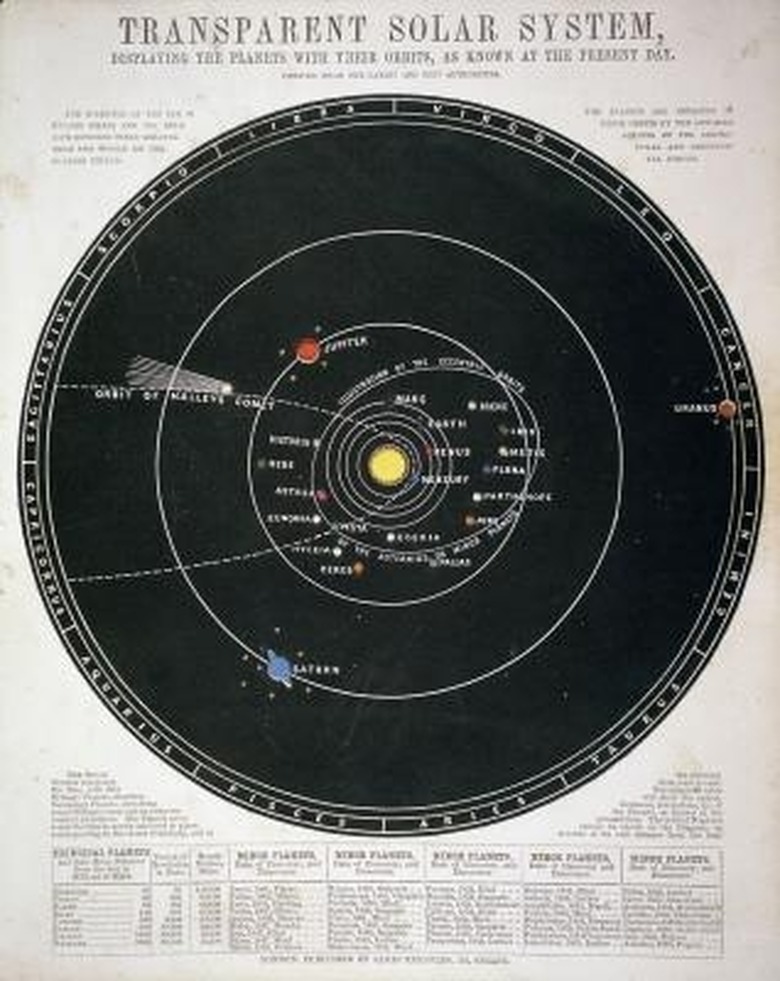About The Sun & Planets
There are eight planets that orbit the central star in the solar system known as the Sun. These planets all revolve around the Sun in somewhat circular orbits and each orbit the Sun in the same plane, which is known as the ecliptic. The planets vary in size, distance from the Sun, and how long they need to complete one orbit of the Sun.
Sun
Sun
The dominant object in the solar system is the Sun, which is a typical star. It is thought to be as much as 4.6 billion years old, and its mass makes up over 98 percent of the entire solar system. The magnetic field of the Sun holds the planets in orbit around it. Composed of 74 percent hydrogen and 25 percent helium, along with other different elements, the Sun converts hydrogen into helium through thermonuclear reactions that occur within its core, creating incredible temperatures that can reach 25 million degrees.
Mercury and Venus
Mercury and Venus
Mercury and Venus are the two planets that have orbits inside that of the Earth's. Mercury is now the smallest of the planets since Pluto was downgraded to a "dwarf planet" by the scientific community in 2006. Mercury is 3,030 miles in diameter and lies at an average of 36 million miles from the Sun, making it the closest planet to the star. It takes a little under 88 days to orbit the Sun and rotates once on its axis every 58.6 days. Venus is the second planet from the Sun and has an orbital period of 224.7 days. Venus has an average temperature of 850 degrees Fahrenheit due to the constant cloud cover that envelopes the planet and keeps the intense heat in. Venus has a diameter of 7,523 miles and is 67 million miles from the Sun.
Earth and Mars
Earth and Mars
Earth is one of the four "terrestrial planets" along with Mercury, Venus and Mars; all four have a rocky core. Earth's distance from the Sun is 93 million miles, allowing life to flourish. The Earth is 7,926 miles in diameter and takes 365.3 days to make it around the Sun once, which is called a solar year. Mars is the fourth planet from the Sun and is the most like Earth. However, it is 142 million miles from the star and takes almost 687 days to make one revolution around it. Mars is 4,222 miles in diameter and needs 24 hours and 37 minutes to spin once on its axis.
Jupiter
Jupiter
The largest of all the planets, Jupiter is 317 times more massive than Earth with a diameter of 88,846 miles. It is the fifth planet in the solar system and is 483 million miles away from the Sun, needing 4,332.5 days to finish an orbit. It spins on its axis rapidly, with a day on Jupiter completed in 9 hours and 55 minutes. Jupiter has no solid surface, as it is composed of hydrogen and ice beneath a deadly atmosphere of helium, methane, and hydrogen. Jupiter has 28 moons, with more being discovered on a regular basis.
Saturn
Saturn
The sixth planet from the Sun, Saturn is the second largest with a diameter of 74,898 miles. It requires 10,759 days to get around the Sun just once and has an average temperature of minus 300 degrees Fahrenheit. Saturn has rings that encircle it that are comprised of rock, ice, and other debris; these rings are visible from Earth and make the planet one of the most viewed objects in the heavens. Saturn has 30 moons and is much like Jupiter in its composition.
Uranus
Uranus
Uranus is unlike the other planets in that it rotates "on its side", possibly the result of some ancient collision with another celestial object. It is the third planet in terms of size, with a diameter of 31,763 miles and Uranus takes 30,684 days to orbit the Sun. It is 1.784 billion miles from the Sun, has 21 moons, and is believed to have a rocky core. However, the warmest it gets on Uranus is minus 300 degrees.
Neptune
Neptune
Even with a diameter of 30,775 miles Neptune is too far from Earth to be seen with the naked eye. It was discovered by using mathematical calculations in 1846 when Uranus's orbit seemed to be affected by another large body. Neptune is 2.794 billion miles distant from the Sun, takes 60,190 days to orbit it just a single time, and has eight known moons, with many more potentially there but unseen by human eyes.
References
Cite This Article
MLA
Lindell, John. "About The Sun & Planets" sciencing.com, https://www.sciencing.com/sun-planets-5078839/. 24 April 2017.
APA
Lindell, John. (2017, April 24). About The Sun & Planets. sciencing.com. Retrieved from https://www.sciencing.com/sun-planets-5078839/
Chicago
Lindell, John. About The Sun & Planets last modified March 24, 2022. https://www.sciencing.com/sun-planets-5078839/
